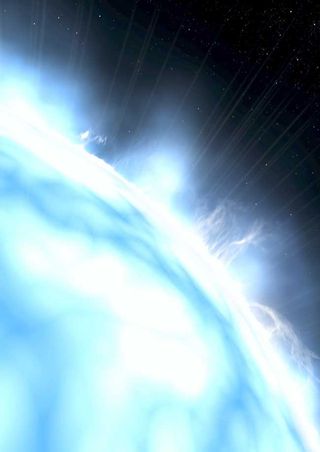New Type of Dying Star Discovered

A rare new kind of star may have been discovered. It is much like the white dwarf our own sun should eventually become—save for a mysterious shroud of carbon ash.
The findings could shed light on the life and death of stars, astronomers said.
After they exhaust all their nuclear fuel, more than 97 percent of the stars in our galaxy—virtually all with eight to 10 times the mass of our sun or less—are expected to end up as white dwarfs, remnant stars roughly the size of Earth and very dense. Our sun is predicted to become a white dwarf more than five billion years from now.
Surprise
Until now, all known white dwarfs had atmospheres rich in either hydrogen or helium. Unexpectedly, scientists now find what seems to be a new class of white dwarf, with skies made primarily of carbon and with little or no trace of hydrogen or helium.
"Nobody ever thought this could exist," astrophysicist Patrick Dufour at University of Arizona at Tucson told SPACE.com. "It will be a challenge to explain how they form."
Roughly 80 percent of all white dwarfs had until now been thought to possess hydrogen-rich atmospheres, with the rest having helium-rich atmospheres. These new carbon-rich white dwarfs seem to be quite rare in comparison, making up at most less than one-thousandth of all white dwarfs.
Get the Space.com Newsletter
Breaking space news, the latest updates on rocket launches, skywatching events and more!
So far, based off observations at Apache Point Observatory in New Mexico, the researchers have found eight such white dwarfs. "There are certainly more," Dufour said.
The scientists detailed their findings in the Nov. 22 issue of the journal Nature.
Dying embers
All white dwarfs form after stars lose up to 85 percent of their mass in their death throes. Perhaps during this phase, a few white dwarfs might lose "practically all of their hydrogen and helium," Dufour said.
"As a result, we see the underlying core of the star where there used to be nuclear reactions," he explained. "The carbon we are seeing are thus the 'ashes' of the burning of helium that once took place in the core of the star."
White dwarfs evolve from stars not massive enough to explode as supernovas upon their deaths. The researchers suggest the carbon-rich white dwarfs are born from stars near this limit, eight to 10 solar masses large.
To learn more about these mysterious new white dwarfs, Dufour and his colleagues plan to focus on the eight they have found so far with bigger telescopes.
"The most important implication here is in regard to stellar evolution," Dufour said. "If they are the result of the evolution of massive stars near the mass limit before exploding as supernova, they could eventually teach us a lot about how massive stars evolve and die."
- Top 10 Star Mysteries
- The Greatest Mysteries in Science
- The Strangest Things in Space
Join our Space Forums to keep talking space on the latest missions, night sky and more! And if you have a news tip, correction or comment, let us know at: community@space.com.

Charles Q. Choi is a contributing writer for Space.com and Live Science. He covers all things human origins and astronomy as well as physics, animals and general science topics. Charles has a Master of Arts degree from the University of Missouri-Columbia, School of Journalism and a Bachelor of Arts degree from the University of South Florida. Charles has visited every continent on Earth, drinking rancid yak butter tea in Lhasa, snorkeling with sea lions in the Galapagos and even climbing an iceberg in Antarctica. Visit him at http://www.sciwriter.us
